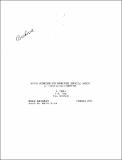| dc.description.abstract | This report is designed to provide a review of those data analysis techniques that are most useful for fitting m-dimensional empirical surfaces to very large sets of data. One issue explored is the improvement
of data (1) using estimates of the relative size of measurement errors and
(2) using known or assumed theoretical relationships. An apparently new concept is developed, named robust weighting, which facilitates the incorporation of a Driori knowledge, based upon the values of input and
response variables, about the relative quality of different experiments.
This is a particularly useful technique for obtaining statistical inferences from the most relevant portions of the data base, such as concentrating on important ranges of variables or extrapolating off the
leading edge of the frontier of knowledge for an emerging technology. The robust weightings are also useful for forcing a priori known asymptotic behaviors, as well as for fighting biases due to shear size of conflicting
data clusters and for formulating separate models for conflicting clusters.
Another new development has evolved from the two very different objectives of the empirical modeling in this project. The first objective is the usual requirement for the best possible predictive mechanism, and standard techniques are useful with their emphasis on model building, specifically
the successive separation of trend techniques. In addition, a second
objective involves the pursuit of high-dimensional, yet simple, models that
could provide insight into analytic gaps and scientific theories that might govern the situation. For this second objective a new stepwise process was developed for rapidly sweeping the data base and producing crude
quantitative measures of the next (or the first) most important m-tuple relationship to incorporate into the empirical model. These quantitative guidelines have been named the fit improvement factors. Some of the
standard statistical techniques reviewed include: graphical displays, resistant models, smoothing processes, nonlinear and nonparametric regressions, stopping rules, and spline functions for model hypothesis; and robust estimators and data splitting are reviewed as polishing and validating procedures. The concepts of setting, depth and scope of the validation process are described along with an array of about sixty
techniques for validating models. Actual data from the recent literature about the performance of fluidized bed combustors is used as an example of some of the methods presented. Also included is a bibliography of more than 150 references on empirical model development and validation. | en |
